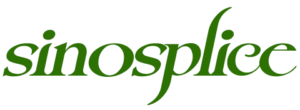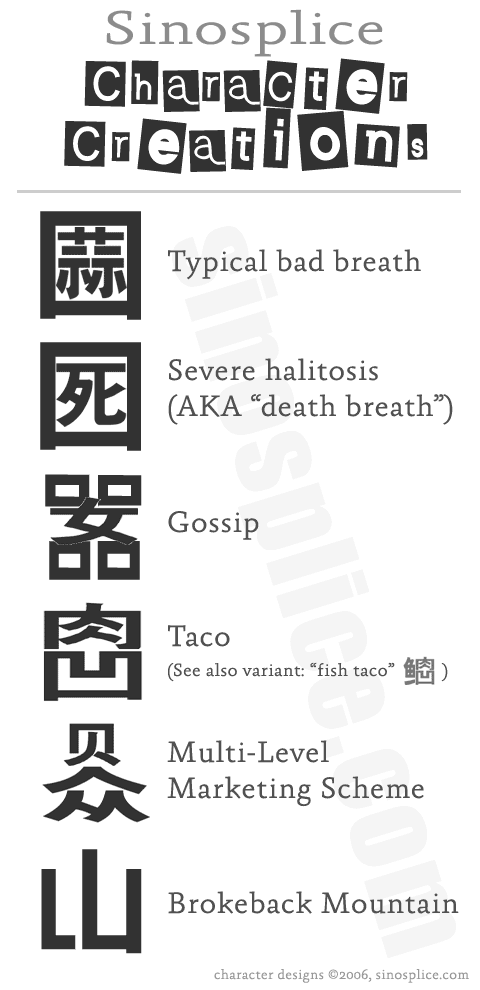Character Creations
An older post by ChinoChano brought my attention to an amusing page on Chinese-Tools.com called New Chinese Characters. The characters are created by foreigners using existing character components (some knowledge of Chinese required). Some of them are pretty funny. Anyway, the page inspired me to create a few new characters of my own:
Key:
1. 口 (mouth) + 蒜 (garlic)
2. 口 (mouth) + 死 (death)
3. four 口 (mouths) + 女 (woman), arrangement based on 器
4. 肉 (meat) on top of 凹 (which means “concave” but represents the taco shell here). (Variant form adds the 鱼 (fish) radical.)
5. 贝 (cowrie, used in characters to mean “money,” as in 财, 购) over 众 (used as a pictographic representation of downlines)
6. 山 (mountain, but broken)
I suspect I will do more of these in the future. It’s kinda fun.


Even with my limited knowledge of Chinese I sniggered out loud. Good work! ‘Gossip’ especially needed little interpretation…
When I saw death breath, I actually thought about “dying in a prison cell” instead, sort of like 囚. Yeah, I know 口 mouth and the enclosing square in 園 or 囚 are slightly different.
I was under the impression that the box around the rest of a character meant walls like wayne said, or as in guo2. If there is a different between that and mouth I sure don’t know it.
Check this: Looking up something in the dictionary this morning and the character 圕 caught my eye. It’s pronounced túshūguǎn (really), and was invented in 1924 by a librarian who thought the three-character version had too many strokes in it. The character seems to turn up as tuān in many lexicons, so maybe the sound as well as the characters got fused.
Great work John!
Even if as Wayne said, the enclosure component 囗 (wéi) and mouth 口 are two different… components, since 囗 doesn’t seem to exist as a character. Congratulations though, these drawings needed quite some imagination! (If your browser displays only squares, don’t worry, it’s not a matter of fonts, I really input squares)
zhwj: This 圕 is a wonderful character. From now on I’ll use it everywhere. 😉
zhwj,
Haha, that’s great! I love bizarre characters like that. That character reminds me of the conversation in the “Multisyllabic Hanzi” post a while back.
Gungun,
Thanks.
Considering I also used 凹 to represent “taco shell” and 众 to represent “downline,” I think focusing on the academic distinction between 口 and 囗 is to miss the point entirely.
And shouldn’t Brokeback Mountain be two 人人 spooned next to each other?
Re: your character for gossip, I’ve always thought it interesting that 奻 meant “quarrel”. I do like the MLM-downline character.
Wayne,
Sorry, the commies are already using 从 for something else.
Maybe you could shove 从 up against 山?
丛山
Mark,
I briefly considered patterning the “Brokeback Mountain” character after 幽, replacing the two 幺 with either two 人 or two 男, but I feel the whole “Brokeback = gay, LOL” meme is already wearing a bit thin, so I decided to go with a more literal (and simpler) interpretation.
Thanks Jhon! How do you create your own character? Do you use some kind of special software?
Haha, good stuff. I like the taco one.
Incidentally, sorry to lower the tone, but did you know that the real character for “the F-word” is 入 over 肉? I heard it was removed from dictionaries. Not sure if that’s true but I saw it written on a toilet wall once!
Sorry, the taco character just reminded me of that.
Dan
Very funny characters!
I cannot pick up any of them… Maybe your “Brokeback Mountain”, as it is simple but effective!
The last one doesn’t feel right — how would you write it?
I imagine that the second to the last one would have the top “radical” span the entire width of the character so that it looked more “square.”
But then again, you’ve been studying chinese for a while at a presigious school, and I’ve just kind of “picked it up.” 🙂
Chinachano,
Just Photoshop, but I actually prefer using Flash for this kind of thing. I used Photoshop anyway, though, because Flash MX is kind of a memory hog.
wtanaka,
If you must know the stroke order of imaginary characters, I can tell you with authority (I invented it, after all) that you would write it left to right, using two L-shaped strokes and one vertical line (L L |).
Yes, other character designers might have used a big fat 贝 at the top of the MLM character, but I wouldn’t want to mislead people into thinking that there’s big money for them in multi-level marketing.
misspelling for misspelling 🙂
I suggest you one “new character” that makes the name of your blog: one that would mix 中 and 合 (I guess “splice” means some kind of union, although sometimes my English with Spanish characteristics betrays me).
I tried to think one for my blog, but “chano” doesn’t mean anything per se.(“chinochano”, all together, means step by step).
hilarious.
Hey John, what about this one?
lol
My girlfriend has one of her own. It is a 女 with dian in the middle. It means “vagina”. Or “bi” in the first tone. Apparently it is fairly common in Baotou and mayhaps Huhehaote in Inner Mongolia. She thinks its maybe came from “叉”. Inner mongolians are perverted though!
[…] in Chinese is, of course, 圣诞节, but in the spirit of my previous Character Creations, I’ve created two new single characters that mean […]
[…] my surprise, I was given credit for the original idea in the photo […]
非常有創意的作品!我正是在潘吉老師的靈感激發下才製作了「疊字」(Gay Chinese Characters) 😀